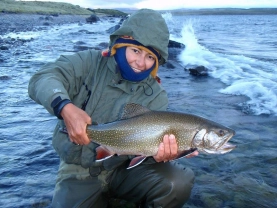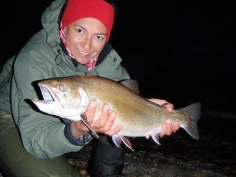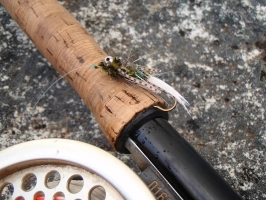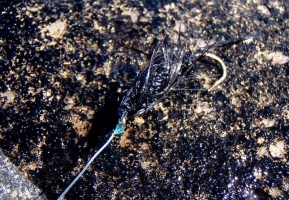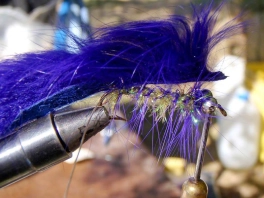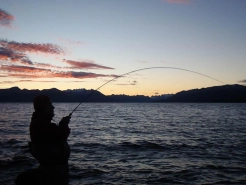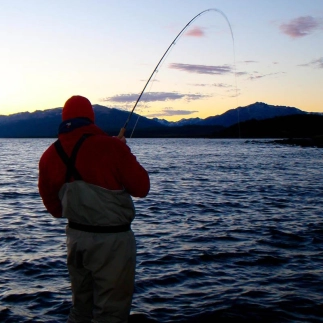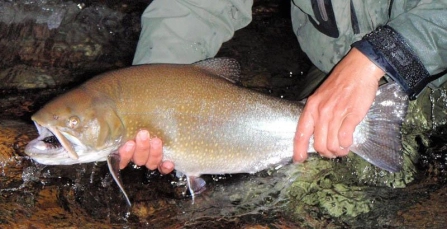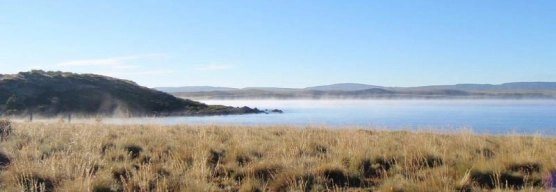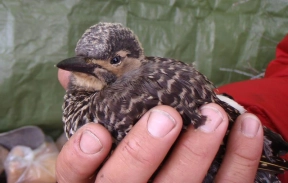Lake Vintter may be the mother of all Patagonian lakes. Huge, rough, windswept high in the mountains and full of huge brook trout and rainbows.
Patagonia. The name sounds tempting, glaciers still growing, barren granite peaks, scenic valleys, snow capped mountains.
And those world famous rivers, which provide nice fishing for all kinds of salmonids - residents and anadromous. No doubt, there is enough space to experience solitude. Just go, pack your daypack and explore and enjoy a day's walk and fishing.
The mother of all Patagonian lakes
But we never told anybody what's most amazing to us living locally. It's the stunning atmosphere of the lakes, some well off the beaten path. Most of them surrounded by impenetrable forest, others nestled in between snowy mountain ridges, or those which seem to be fenced by the water itself, like a fortress protecting its treasures.
One of them, if not the mother of all Patagonian lakes, lies almost 900 meters or 2700' above sea level, the lake covers 135 square kilometers or more than 50 square miles.
It's a majestic plane of water, whether you approach from the south or the north, which is my favored approach. A rugged dusty gravel track, which cuts through the mountain ridge in steep narrow hairpins. The first view of the lake itself will enchant you, a deep blue surface of water, lovely framed by a graveled shoreline, nicely arranged driftwood.
Cut!
Spray laden whirlwind, pale white and tall, like multi storied buildings, blasting across the lake. Massive waves breaking on the shore and the entire place suddenly seems like hell's kitchen.
May I introduce you to Lago General Vintter.
The biggest part is named after General Vintter (son of German immigrants 1842-1915) and belong to the Republica Argentina and the more remote part which is only accessible by horse or boat is called Lago Palena and is on Chilean territory.
We save the more pleasant and welcoming appearance for the next morning, or the day after tomorrow. Fact is, there aren't any rules apart from the moon phase
Be prepared for the roughest climate you will experience on this latitude.
The weather
There's a lot of it! Be prepared for the roughest climate you will experience on this latitude.
Lake Vintter is flanked by Mountain ridges up to 7.400 ft. Another geological oddity is the position of the lake itself. It stretches from west to east and literally cuts through the Andean chain, forming a huge tunnel and gives the constant westerly wind even more power to batter the shore and the fisherman's nerves.
Thunderstorms aren't rare either, particularly during full moon. They are generated by the combination of cold pacific winds and the occasional warm days here, and thundering around the lake during summer. Temperatures up to 70 degrees F in between days with snow is nothing unusual. This lake sure is a moody fellow and doesn't reveal its treasures easily.
We bring our fly rods
Walking on the graveled shore, to the left the vast plane of water on the other side the dense forest of nothofagus or southern beech, trees which are hundreds of years old. It gives you a taste of almost untouched nature.
And yes, we bring our fly rods, since this lake offers the most remarkable fly fishing for the biggest Brook Trout.
Fierce wind
The fierce wind is a more like a constant phenomenon than a thing which occurs once in a while. That means that nature can be very rough and unpleasant. Casting lightweight tackle, long leaders and tiny little dries don't always work out well.
Sure, you can have a hatch where rising fish gives you a unforgettable time on the water, and even the majestic lake dwellers appear out of the deep to sip in a well presented "seca" - a dry fly.
All this preferably on the edge to the blue water, but you have to be lucky, or pray to the god of all those Patagonian winds to hold them for a while. Of course, there's always a well sheltered place to find, where the westerly wind doesn't blow choppy riffles across the lake.
Available food sources
Aquatic life here isn't too different from other lakes, but the nutrition density is very poor. You will find small crustaceans like the gammarus, which appear in substantial numbers in the remote zones. Nymphs of stonefly, mayfly and caddis, as well as chironomids are the most common food sources for feeding trout.
And then there are a very few indigenous fish species like Galaxias platei, AKA puyen grande, which might be on the trout's menu.
Minnows are absent in this lake, due to unfavorable conditions. They are found in the smaller feeder streams and mainly in the Corcovado River itself.
The pancora, a freshwater crayfish, which is common elsewhere and usually reaches good sizes, is also absent in this region.
Serving or surf the menu
So, how to approach those beauties? No hatch, no sign of a rising brookie or even a rainbow. A fairly nice breeze is moving the gin clear water gently towards the big boulders and the graveled shore.
Let's start with the tackle. I would go for something between a 5 and a 6 weight in 9 or 10 feet and a DT line. It may sound strange. Not because of my favored lightweight rods. No, because of the DT line. If I didn't know better, I would mount my WF line right away, with a heavy sink tip, or maybe even go for a sinking line and fire it out into the deep blue!
But our approach is more cautious.
First we fish our line with long leader and a dry-attractor flies. From size 6 up to 4 or even 2 depending on whether we use long shank hooks in x2 or up to x4. Remember, there's no activity and we have to draw attention. We start casting parallel to the shore and incline the angle of presentation toward the open water. Use a double haul to get distance, so you bring out more line what increases your retrieve time and keeps your fly longer where it's supposed to be, on the water to catch fish. This tactic also reduces your casting frequency.
It's common to get one of the wild boys, hand long brookies. We call them "saltarines". They go even for the biggest fly. When you start getting them, you'd better be off or change your tactic!
But at least we gave it a shot!
If you have a float device, a float tube or a pontoon boat, don't start pounding the shoreline first, but do it the opposite way, from the outside in.
Imitate or stimulate
We didn't trigger any attention with the big dry we used before. A reason might be that there are no fish. Another option is that there are fish, but from the depth they weren't able or willing to rise. Many factors determine whether the fish take the fly and light sure is one of the them. The silhouette of a dark pattern fished in the depths is easily visible for the fish while the bright fly in the shallows or sunny conditions might guarantee a take. Sometimes we forget that fish do not necessarily think in a logical way, and they do not necessarily interpret or see things as we do.
Now I change to a sink tip, a fairly short leader and a weighted fly. Casting procedure will be the same.
Imitation or stimulation is our weapon of choice, or better, the hassle what pattern to take when there's no activity, no hatch. It doesn't make any sense to keep on trying to imitate any nymph or dry pattern. The fish wouldn't pay attention because, he is in slow motion mood, saving energy for something worth it.
There has to be!
I would suggest, a bright pattern on a sunny day, even loaded with some glitter for reflections. Overcast days might require a much darker pattern, but we already talked about this.
For sure there is some trout or brookie around. There has to be!
As a matter of fact they are cruising in depths that our fly could easily reach. More than often we see them, even through fairly choppy water breaking the surface, something triggered their attention.
We already left the classical way, so why not trying something more tempting? In fact, a highly voluminous pattern. A bushy marabou tail, long fibered hackle, rubber legs, a nicely shaped deer hair head with some weight, chain eyes, or something heavier.
I usually tend to choose the more weighted pattern, because since I am a pragmatic person, the heavier fly is passing the shallower zone anyway. So, no need to fumble with your knots on a crispy casual Patagonian day, to change the fly pattern again.
Dusk
It has been a wonderful day, not too cold, some wind, some drizzle, a few nice fish. No matter the size, they are all gorgeous, whether you hooked a rainbow, with those sparkling chrome flanks, or a colorful brook trout.
The fish is always just a part of the whole thing for us. The crown on a long day in nature, but the fish never counts alone.
It was a fairly long hike from our camp to the last wind covered bay of the lake. So strolling back, we always take time to focus on the small features, turning around stones in the shallows, a habit of my long gone childhood.
I was always curious about those crawling things, hidden close to the shore. Today, curiosity remains and I like to take some snapshot of the aquatic life.
The firewood is also gathered on the way "home". Depending on when we left on the morning or midday, we have to eat something to recover energy. A steaming, rich soup accompanied by some "pan" - bread - and corned beef followed by an strong, nicely sugared coffee!
Second encounter
Around 9PM is a good time to get the ready tackle again. Long leader, floating lines, dark patterns. We skipped the dry fly hour. There was none!
Now we focus on the close shore. Our antagonists recently left the shelter of the depths and patrol close to the huge boulders, almost in front of our feet.
According to our experience, the rainbows seem to prefer the early morning hours. Late evenings it changes to favor the brook trout.
We made another interesting observation. In the shallows, even without big boulders, the lake bottom is scattered with fist size stones. In this type of type water, the brook trout is absent. It's the habitat of the rainbows, and they keep distance to the close shore, even during fading daylight.
The distinct takes are well worth mentioning: A real take, meaning ripping the line out of the hand and it's a rainbow. A more hesitating and shy take, and we're into a brook trout.
Day is getting to its end and as the daylight fades. The takes are no longer hesitant. The takes are hard and the average brook trout now weights up to 4 lbs and they do not lack any fighting spirit at all!
But they need to be drilled out wisely because unlike the rainbow, the mouth of the brooks is more soft and a harsh, short drill often resumes in losing the fish!
Avoid any slack in your line and instantly get in contact to your fly when your fly touches the surface. Once after the fly had touched the water, I was immediately into something big. The line was snatched away from me and whatever took the dark fly, it got away after shaking and twisting furiously...
Memories of lost fish like this gives this lake more mystic than any other stream could provide.
Before daylight
It's dark now and reaching the camp well after midnight is the rule rather than the exception.
Talking about the austral summer, days are long, 18 hours of sunlight means a lot of fishing if you follow the Patagonian fishing regulations. Other ambitious anglers are awake before the first daylight, but for me this is more barbarism than a joy. I admit that our days out there start with a mug of steaming coffee and a hearty breakfast well after sunrise!
But next time, we will be up before daylight, promise...
Prime time tactics
As mentioned before early morning and late evening hours are the prime times to get the trophies. Fishing during dawn gives you a significant time bonus: you have at least 2 hours more.
The dusk is our favored time to stalk the big brookies. But unlike the morning you just have one hour in between sunset and remaining daylight!
And here comes: to enjoy pure fishing during prime time explore the hot zones when the sun is to your favor, usually in the early mid day. There is nothing more annoying and dangerous than stumbling around in the dark between slippery rocks and seeking for deep pools, which you wouldn't find anyway.
Important advice
La boca like the "baqueanos" (locals) say, must be fished with great respect. Wading in a common sense is tempting on the graveled bank. But the gin clear water makes it almost impossible to estimate the depth. Also be aware of the extremely strong current. The left hand bank with its big and slippery boulders should be treated with much more respect and even avoided for anyone who is in doubt of his "climbing skills".
The "Kindergarten"
Not to talk about the Corcovado river in conjunction the Vintter lake would be like Jazz without a saxophone! This river itself is the main spawning ground for Patagonia's biggest brook trout and famous for its autumn spawning run from late March to the beginning of May.
And last but not least the boca as well is feeding ground for the "barracos" the big rainbows and their run late in the year, but that's another story...
- Log in to post comments















